Multiple mechanisms are responsible for transactivation of the epidermal growth factor receptor in mammary epithelial cells
- PMID: 18782770
- PMCID: PMC2581561
- DOI: 10.1074/jbc.M800456200
Multiple mechanisms are responsible for transactivation of the epidermal growth factor receptor in mammary epithelial cells
Abstract
The number of distinct signaling pathways that can transactivate the epidermal growth factor receptor (EGFR) in a single cell type is unclear. Using a single strain of human mammary epithelial cells, we found that a wide variety of agonists, such as lysophosphatidic acid (LPA), uridine triphosphate, growth hormone, vascular endothelial growth factor, insulin-like growth factor-1 (IGF-1), and tumor necrosis factor-alpha, require EGFR activity to induce ERK phosphorylation. In contrast, hepatocyte growth factor can stimulate ERK phosphorylation independent of the EGFR. EGFR transactivation also correlated with an increase in cell proliferation and could be inhibited with metalloprotease inhibitors. However, there were significant differences with respect to transactivation kinetics and sensitivity to different inhibitors. In particular, IGF-1 displayed relatively slow transactivation kinetics and was resistant to inhibition by the selective ADAM-17 inhibitor WAY-022 compared with LPA-induced transactivation. Studies using anti-ligand antibodies showed that IGF-1 transactivation required amphiregulin production, whereas LPA was dependent on multiple ligands. Direct measurement of ligand shedding confirmed that LPA treatment stimulated shedding of multiple EGFR ligands, but paradoxically, IGF-1 had little effect on the shedding rate of any ligand, including amphiregulin. Instead, IGF-1 appeared to work by enhancing EGFR activation of Ras in response to constitutively produced amphiregulin. This enhancement of EGFR signaling was independent of both receptor phosphorylation and PI-3-kinase activity, suggestive of a novel mechanism. Our studies demonstrate that within a single cell type, the EGFR autocrine system can couple multiple signaling pathways to ERK activation and that this modulation of EGFR autocrine signaling can be accomplished at multiple regulatory steps.
Figures

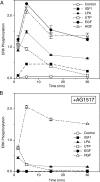

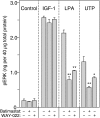
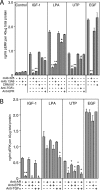
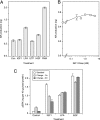
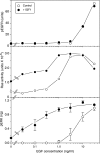


Similar articles
-
Lysophosphatidic acid promoting corneal epithelial wound healing by transactivation of epidermal growth factor receptor.Invest Ophthalmol Vis Sci. 2007 Feb;48(2):636-43. doi: 10.1167/iovs.06-0203. Invest Ophthalmol Vis Sci. 2007. PMID: 17251460 Free PMC article.
-
Structure of the EGF receptor transactivation circuit integrates multiple signals with cell context.Mol Biosyst. 2010 Jul;6(7):1293-306. doi: 10.1039/c003921g. Epub 2010 May 10. Mol Biosyst. 2010. PMID: 20458382 Free PMC article.
-
ERK1/2 mediate wounding- and G-protein-coupled receptor ligands-induced EGFR activation via regulating ADAM17 and HB-EGF shedding.Invest Ophthalmol Vis Sci. 2009 Jan;50(1):132-9. doi: 10.1167/iovs.08-2246. Epub 2008 Jul 24. Invest Ophthalmol Vis Sci. 2009. PMID: 18658095 Free PMC article.
-
Dependence of peroxisome proliferator-activated receptor ligand-induced mitogen-activated protein kinase signaling on epidermal growth factor receptor transactivation.J Biol Chem. 2003 Nov 21;278(47):46261-9. doi: 10.1074/jbc.M307827200. Epub 2003 Sep 9. J Biol Chem. 2003. PMID: 12966092
-
ADAMs as mediators of EGF receptor transactivation by G protein-coupled receptors.Am J Physiol Cell Physiol. 2006 Jul;291(1):C1-10. doi: 10.1152/ajpcell.00620.2005. Am J Physiol Cell Physiol. 2006. PMID: 16769815 Review.
Cited by
-
An extensive survey of tyrosine phosphorylation revealing new sites in human mammary epithelial cells.J Proteome Res. 2009 Aug;8(8):3852-61. doi: 10.1021/pr900044c. J Proteome Res. 2009. PMID: 19534553 Free PMC article.
-
ERBBs in the gastrointestinal tract: recent progress and new perspectives.Exp Cell Res. 2009 Feb 15;315(4):583-601. doi: 10.1016/j.yexcr.2008.10.043. Epub 2008 Nov 7. Exp Cell Res. 2009. PMID: 19041864 Free PMC article. Review.
-
Integrated analysis reveals that STAT3 is central to the crosstalk between HER/ErbB receptor signaling pathways in human mammary epithelial cells.Mol Biosyst. 2015 Jan;11(1):146-58. doi: 10.1039/c4mb00471j. Epub 2014 Oct 15. Mol Biosyst. 2015. PMID: 25315124 Free PMC article.
-
Lysophosphatidic Acid Signaling in Cancer Cells: What Makes LPA So Special?Cells. 2021 Aug 11;10(8):2059. doi: 10.3390/cells10082059. Cells. 2021. PMID: 34440828 Free PMC article. Review.
-
Met receptor acts uniquely for survival and morphogenesis of EGFR-dependent normal mammary epithelial and cancer cells.PLoS One. 2012;7(9):e44982. doi: 10.1371/journal.pone.0044982. Epub 2012 Sep 13. PLoS One. 2012. PMID: 23028720 Free PMC article.
References
-
- Gschwind, A., Zwick, E., Prenzel, N., Leserer, M., and Ullrich, A. (2001) Oncogene 20 1594–1600 - PubMed
-
- Schafer, B., Gschwind, A., and Ullrich, A. (2004) Oncogene 23 991–999 - PubMed
-
- Kue, P. F., Taub, J. S., Harrington, L. B., Polakiewicz, R. D., Ullrich, A., and Daaka, Y. (2002) Int. J. Cancer 102 572–579 - PubMed
-
- Prenzel, N., Zwick, E., Daub, H., Leserer, M., Abraham, R., Wallasch, C., and Ullrich, A. (1999) Nature 402 884–888 - PubMed
-
- Xi, S., Zhang, Q., Dyer, K. F., Lerner, E. C., Smithgall, T. E., Gooding, W. E., Kamens, J., and Grandis, J. R. (2003) J. Biol. Chem. 278 31574–31583 - PubMed
Publication types
MeSH terms
Substances
Grants and funding
LinkOut - more resources
Full Text Sources
Other Literature Sources
Research Materials
Miscellaneous

